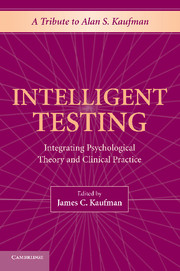Book contents
- Frontmatter
- Contents
- Acknowledgments
- Alphabetical List of Authors and Affiliations
- PART ONE THOSE WHO KNOW HIM
- PART TWO INTELLIGENT TESTING
- PART THREE THE INTERSECTION OF THEORY AND MEASUREMENT
- 8 Kaufman on Theory, Measurement, Interpretation, and Fairness: A Legacy in Training, Practice, and Research
- 9 The Theory of Successful Intelligence as a Basis for New Forms of Ability Testing at the High School, College, and Graduate School Levels
- 10 Kaufman's Work in the Penumbra between Measurement Science and Clinical Assessment
- 11 Success Is a Latent Variable: How Alan Kaufman Shaped Intelligence Test Theory, Interpretation, and Psychometrics with Factor Analysis
- PART FOUR KAUFMAN ACROSS THE WORLD
- Author Index
- Subject Index
- References
10 - Kaufman's Work in the Penumbra between Measurement Science and Clinical Assessment
Published online by Cambridge University Press: 05 August 2012
- Frontmatter
- Contents
- Acknowledgments
- Alphabetical List of Authors and Affiliations
- PART ONE THOSE WHO KNOW HIM
- PART TWO INTELLIGENT TESTING
- PART THREE THE INTERSECTION OF THEORY AND MEASUREMENT
- 8 Kaufman on Theory, Measurement, Interpretation, and Fairness: A Legacy in Training, Practice, and Research
- 9 The Theory of Successful Intelligence as a Basis for New Forms of Ability Testing at the High School, College, and Graduate School Levels
- 10 Kaufman's Work in the Penumbra between Measurement Science and Clinical Assessment
- 11 Success Is a Latent Variable: How Alan Kaufman Shaped Intelligence Test Theory, Interpretation, and Psychometrics with Factor Analysis
- PART FOUR KAUFMAN ACROSS THE WORLD
- Author Index
- Subject Index
- References
Summary
Like all chapters in this book, we wish to document another one of Dr. Alan S. Kaufman's contributions, one that we think is of greatest impact on the disciplines of psychology, school psychology, educational psychology, and related fields. We think that his most innovative work, and the contribution likely to have the most long-term impact, was his joining of the two disciplines of measurement science and clinical assessment practice. He did so by essentially creating a new methodology of intelligence test interpretation, a method that has spread to clinical assessment practice in general, and it may be characterized in today's terminology as an early form of “evidence-based” test interpretive practice, one that emphasizes a psychometric approach to evaluating individual performance on a battery of tests as expressed as test scores.
Professor Kaufman's innovative insight is typical of breakthroughs that are made in the space between traditional boundaries, in this case, between two disciplines that were not closely aligned prior to the publication of his seminal 1979 work, Intelligent Testing with the WISC-R. His work takes its place alongside other breakthroughs such as the merger of mathematical modeling and chemistry to form the field of quantitative chemistry, combining the fields of physics and mathematics to create magnetic resonance imaging equipment, and merging information technology and health care to create the field of health informatics.
- Type
- Chapter
- Information
- Intelligent TestingIntegrating Psychological Theory and Clinical Practice, pp. 148 - 156Publisher: Cambridge University PressPrint publication year: 2009
References
- 2
- Cited by



